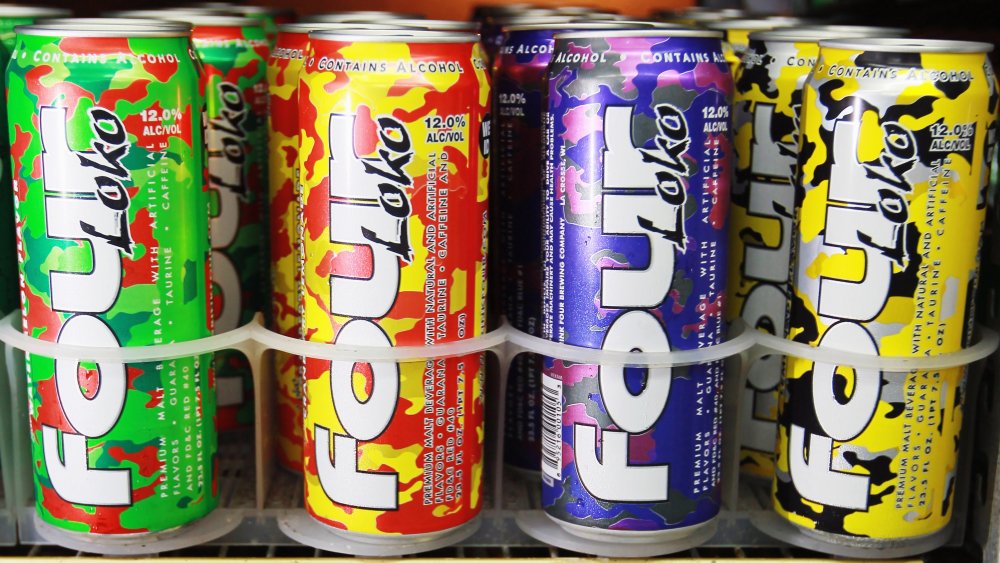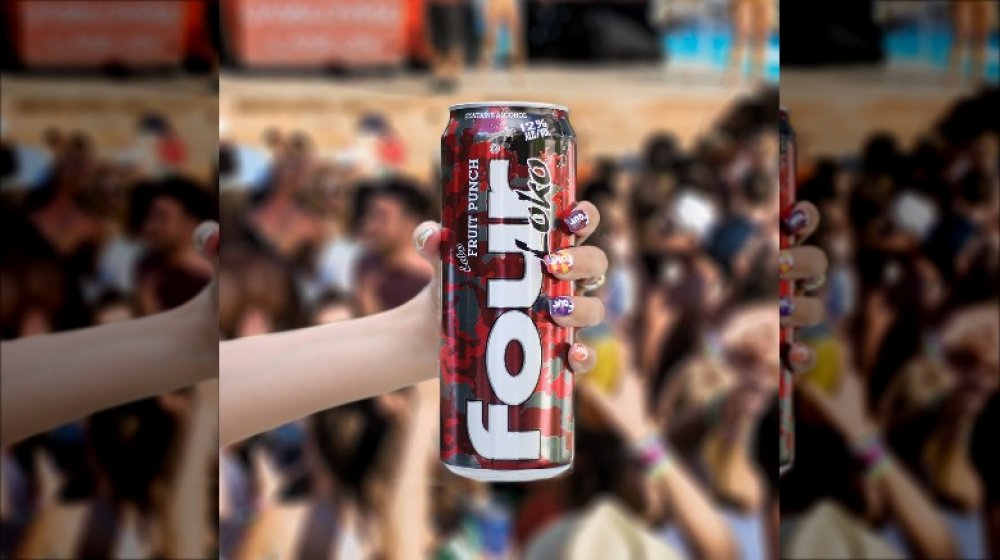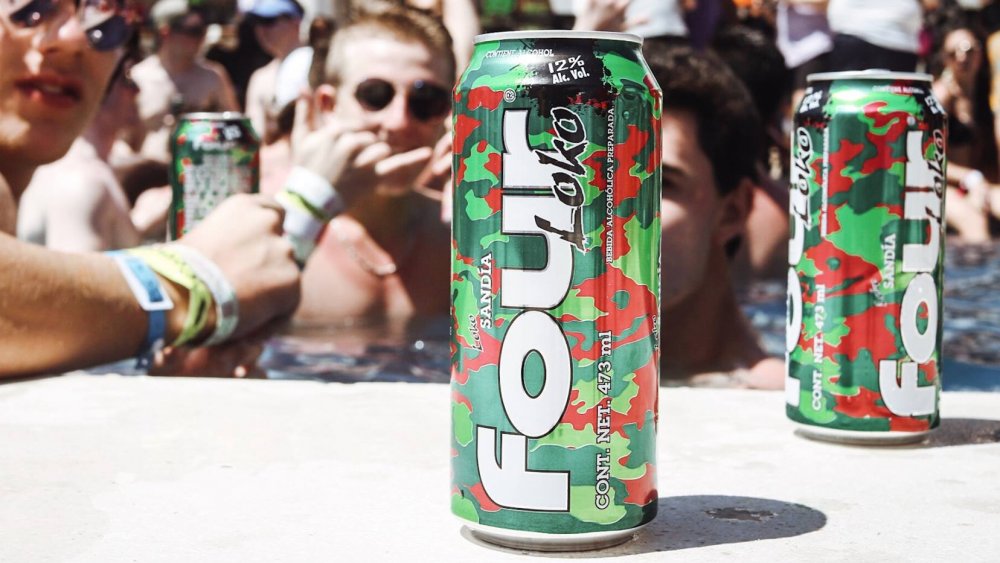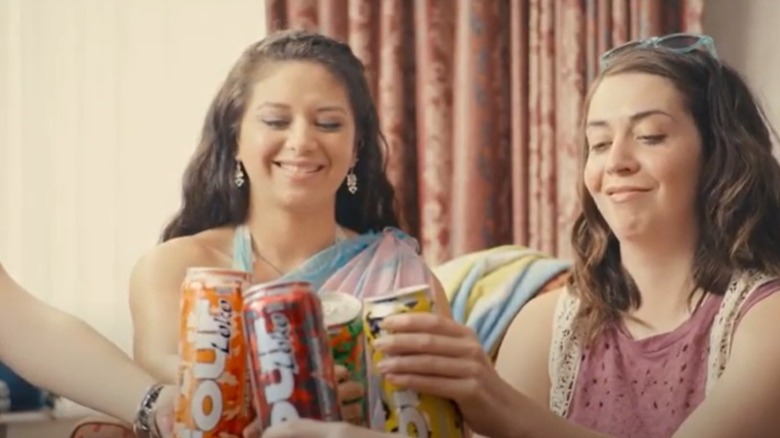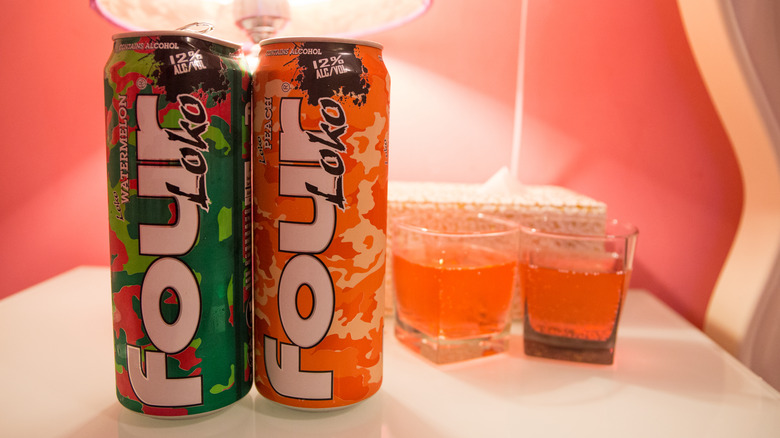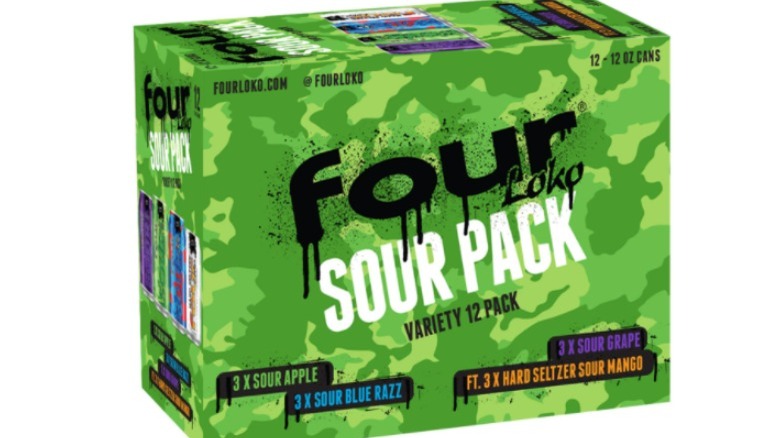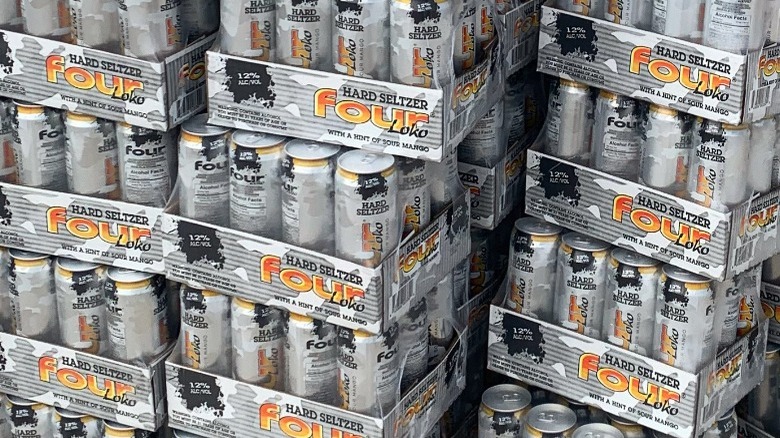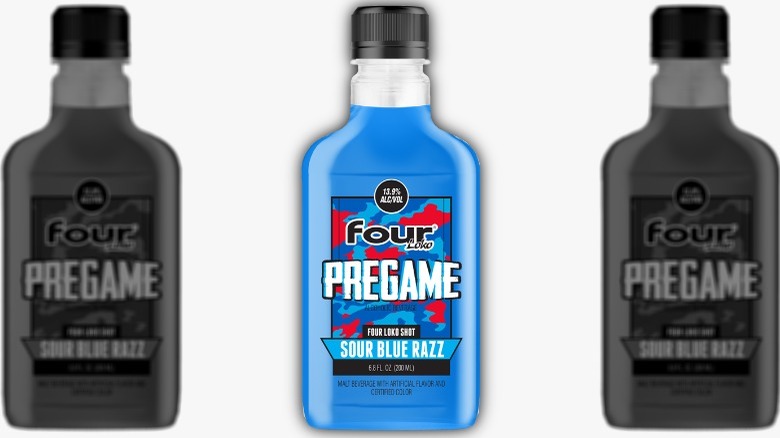The Untold Truth Of Four Loko
If you're old enough to remember the early 2000s, you probably remember the malt beverage Four Loko. If you didn't drink it at least once just to see what all the fuss is about, you definitely heard about the controversy surrounding the product, which was widely reported on in 2010.
The Week states that at its most popular (and most controversial), Four Loko contained up to 12% alcohol and came in eight fruit-based flavors. The malt liquor drink became popular with college-aged students due in part to its combination of caffeine and alcohol, which allowed drinkers to consume more than they might be capable of under normal circumstances.
But after a series of incidents, including one event in which 17 students and six visitors to New Jersey college Ramapo had to be hospitalized following a night of binge drinking linked to the brand (per ABC 7), as well as the death of a young man who was known to have been drinking Four Loko heavily, many began calling for a ban on sales of the drink.
Four Loko's beginnings
Four Loko was first introduced in 2005, as told to Grub Street by Jaisen Freeman and Jeffrey Wright, the beverage's co-creators. Inspired by the emerging market for energy drinks spiked with alcohol (like the "energy beer" Sparks and the still popular mix of Red Bull and vodka), the pair, along with a third business partner, decided to attempt to create a new product to take advantage of the relatively small amount of competition.
After attempting to trademark a series of names, they decided to go with Four Loko. The "four" in Four Loko represents the four key ingredients in the drink, and was chosen because they felt names with numbers in them were successful. To help create the flavor for the drink, the company enlisted a group of friends to work as taste testers. They originally wanted the flavor to be similar to cherry vodka, but decided to test the product on the market once they found something everyone agreed they would be willing to drink.
Initially, the beverage did not perform well, leading the pair to go back and make some changes. They decided to make the cans larger, raise the alcohol level, and redo the flavor to create a more palatable taste than the one they had originally settled on. They also added Four Loko's signature neon camouflage print to the cans, which was chosen to help the product stand out more from other malt beverage drinks on store shelves.
The controversy
The real trouble for the company came in 2010, when drinking Four Loko was linked to a series of injuries and deaths in young people. Mixing caffeine and alcohol can be extremely dangerous, according to the Centers for Disease Control and Prevention, as caffeine masks the depressant effects of alcohol and can cause people to become much more drunk than they realize.
The Legal Examiner states that the infamous four ingredients in Four Loko that caused the drink to be such a dangerous blend were alcohol, taurine, caffeine, and guarana, which are three stimulants and one depressant. Each 24-ounce can contained as much alcohol as four to six beers and as much caffeine as four to six cups of coffee.
In 2010, the Federal Trade Commission sent out a letter warning energy alcohol manufacturers that they may come into legal trouble for deceptive marketing, as the products posed a safety risk to those drinking them. In response to this letter, Four Loko decided to reformat its blend to remove the stimulants from its drinks.
Four Loko and colleges: a love/hate relationship
Given Four Loko's ability to get consumers very drunk — and to do so rather quickly — it's no surprise it was popular on college campuses. But, according to Thrillist, in 2010, as hospitalizations due to over drinking rose among students across the country, some students, and many administrators, became less enamored with Four Loko. The Yale Daily News reported that Four Loko was "in a whirlwind romance with college students" (via Thrillist), while CNN called it "a binge-drinker's dream."
Nine students at Central Washington University were hospitalized after drinking Four Loko, and it wasn't long after until similar events started popping up at other college campuses across the country. Ramapo College banned it after 16 student hospitalizations for alcohol poisoning, and Boston University warned students of the dangers of the beverage and advised them to steer clear. As entire states started to ban the drink, some college students rallied around Four Loko, with some looking to lawmakers for support. But their efforts were in vain, as the original Four Loko recipe was eventually taken off the market, per Thrillist.
The FDA issued Four Loko a warning about its original recipe
In November 2010, the Food & Drug Administration issued a letter to Phusion Projects, as well as to three other companies that produced caffeine-charged alcoholic beverages, regarding Four Loko's caffeine content, warning the company that caffeine had been deemed an "unsafe food additive" and of a potential seizure of their product.
"While not an outright ban, the FDA says it's the first step in that direction," reported ABC News at the time. While Phusion Projects' co-founders and managing partners maintained Four Loko was as safe as enjoying two glasses of wine with dinner and then having a cup of coffee, they were faced with "a difficult and politically-charged regulatory environment at both the state and federal level," reported CBS News. Phusion Projects was given 15 days to respond. But the company had anticipated the warning and already had an action plan to alter its recipe, removing the caffeine from the drink, per ABC News.
Four Loko also changed the way it marketed itself. According to CBS, a second case, settled in New York in 2014, was directed at Four Loko's marketing. In the agreement reached, Phusion Projects admitted no wrongdoing but promised not to promote the product to underage people, in schools, or on college campuses; to not post any promotional material depicting or condoning misuse of alcohol; and to no longer hire any models under the age of 25 or who appeared to be under 21.
A Four Loko black market emerges
Just before the FDA issued its warning about the potentially hazardous nature of Four Loko in its original form, both fans of the drink and people looking to make some cash started stocking up on the beverage, and an underground Four Loko black market emerged.
NBC New York reported that in January 2011, Four Loko was "one of the hottest products on Craigslist." In a hidden-camera investigation, reporters were able to buy a case of 12 cans of Four Loko after responding to a Craigslist ad. The case was purchased for $80, which the station reported was a mark-up of 300%. When confronted, the seller said he was marketing the Four Loko cans as collectable items.
Not only is it illegal to sell alcoholic beverages without a liquor license in every state, but James Batelli, a New Jersey police chief, also pointed out at the time that those selling the drinks were ignoring the safety risks and putting others in danger. "It's a very expensive black market item that people are price gouging and making a lot of money on and they're making a lot of money on people's health," Batelli said to NBC New York in 2011.
Leftover Four Loko is converted into fuel
So, what happened to all the extra original Four Loko that had already been produced when Phusion Projects pulled the original recipe? Luckily for the planet, it didn't go to waste, as some Four Loko from wholesalers and distributors, as well as extra product from Phusion Projects itself, was shipped to MXI Environmental Services in Abingdon, Virginia and to two other plants where it was transformed into ethanol.
Hundreds of truckloads — each truckload contains 2,000 cases — of Four Loko started arriving at the recycling facility in early 2011 after FDA's warning about caffeinated alcoholic beverages in November 2010. Not only was the alcohol from the beverages distilled and used as auto fuel, but MXI Environmental Services also took care of the whole package, recycling the cans, water, cardboard boxes, and shipping pallets.
Brian Potter, Vice President of Operations at MXI Environmental Services, pointed out at the time that these cans could have easily gone into an incinerator or landfill, calling the recycling efforts "a good thing" in a statement to NBC News.
Is Four Loko's new product as dangerous as the original?
Come 2020, Four Loko was not only looking for ways to get back in the game, but it was also looking for ways to help get the party started. And so, Four Loko Pregame was born.
While still malt beverage-based like regular Four Loko, Pregame was marketed as a shot version of the drink containing 13.9% alcohol by volume. The drink lacks carbonation; as Delish suggests, it can be enjoyed as a shot or with a mixer. Originally available in Sour Blue Razz, Lemonade, and Sour Peach, Four Loko Pregame has since added Sour Grape and Wicked Tea to its list of flavors.
Upon its public reveal, an Eater article questioned the company's integrity concerning releasing another potentially blackout-inducing drink and party product in the middle of a pandemic, claiming Four Loko had "returned to its dirtbag roots." Four Loko, on the other hand, states on its FAQ page that its drinks are only bad for you "if you hate having a good time," though the company does encourage fans to enjoy them responsibly.
